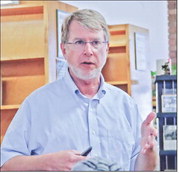Marathon Co. adopts budget priorities for 2026
Marathon County supervisors took the first step toward crafting a 2026 budget last week, officially adopting priorities and assumptions for the county administrator to follow when developing his proposal for the board to consider in September.
The debate leading up to last week’s vote captured the varying perspectives that go into developing the multi-million dollar budget. Some supervisors want to keep the focus on tax relief. Others want to see more attention on energy efficiency in county buildings. For the county administrator, increasing compensation for employees to keep up with the competitive job market is a top priority.
Ultimately, the board adopted a series of budget assumptions and priorities that mostly mirrored what had originally been proposed at the committee level, such as a freeze on adding new county positions and a prohibition on using capital reserves for operating expenses and debt service.
Other assumptions dealt specifically with the county’s largest expense, staffing. The top priority is to implement a new compensation study, which will likely mean higher wages for county employees based on what similar workers in the area are being paid, with the goal of retaining and recruiting employees.
Supervisor Gayle Marshall objected to including the phrase “market study” in the list of budget assumptions, which otherwise includes specific percentages indicating how much certain expenses are projected to increase from one year to the next. (Over the last two years, for example, wages went up by 3 percent each year).
“It’s hard to vote for this considering we don’t know what that number is,” she said. “The word ‘market study’ could mean anything at this time, so I will not be supporting this because we have no idea what ‘market study’ means.”
Supervisor John Robinson said the term should really be “market rate” to reflect the prevailing wages for county employees as determined by the administrator and human resources director getting updating wage numbers. The county’s compensation schedule was last updated in 2022, which provided raises as way to reduce turnover among county employees who could find better pay elsewhere.
“If you recall, a couple of years ago, we were basically hemorrhaging staff because our rates were not competitive,” Robinson said.
At the same time, however, Robinson said it will be up to the board to decide where the county wants to situate itself on the range of compensation being offered by employers in the area, with the understanding that it may not be able to afford the raises it wants to give.
“We still have to live within our means,” he said. “We have a relatively restrictive levy limit, we have limited resources and we’ll have to balance it.”
The Human Resources, Finance and Capital Committee is expected to review the results of the wage study in August, with the goal of providing the full board with a recommendation for wage increases.
At the HRFC’s most recent meeting on July 22, Marshall questioned the 6.5 percent increase being projected for health insurance next year. Rather than just passing on rate hikes to the taxpayers, she said employees should be asked to pay more for their own benefits. She pointed out the 90 percent coinsurance paid by the county as an example of something that most other employers don’t offer.
“I do think we need to look at the provisions in the plan to bring that cost down,” she said.
Board chairman Kurt Gibbs, however, said health insurance renewal rates are closer to 10 percent nationally, and one neighboring county, Portage, was recently hit with a hike of over 20 percent. He called the 6.5 percent “a starting point” for budget discussions.
Marshall made a motion to reduce the projected health insurance increase from 6.5 percent down to 3.7 percent, but the committee narrowly voted it down. Committee members also discussed ways of mitigating the impact of increasing energy costs, especially at the recently vacated buildings on River Drive and Thomas Street in Wausau.
Chris Holman, director of Facilities Management, said the utility costs for maintaining the River Drive and Thomas Streets properties is estimated to be just shy of $60,000 per year. Holman also provided the committee with estimated rate increases for water, natural gas and electricity, which range from zero for water to 5 to 9 for gas.
When Robinson asked what the county is doing to reduce its energy consumption, Holman listed a series of changes his department has made, such as setting thermostats at the lowest possible temperatures, installing LED lights, automatically shutting off lights and reducing their brightness by 10 percent.
Holman said the new regional forensic science center in Wausau is “a wild card” at this point, as the facility was just recently constructed. He noted that groundsource heat was installed at the facility, which should lower energy costs.
Supervisor Ann Lemmer, who previously proposed a task force to look for energy efficiency within county operations, said she would welcome a presentation on the potential of rooftop solar panels and other technologies that could help reduce energy costs.
The committee, and later the board, voted to include a 5 percent estimated increase in utility costs for next year.
Revenue was also a big topic of conversation for the HRFC, with particular attention paid to potential sources of money outside of the property tax levy.
Supervisor Scott Poole successfully introduced an amendment to make it clear that the county board seeks to maintain “a sustainable property tax levy” and “to maximize non-levy revenue streams to assist” in doing that.
“With the cost of living and affordability continuing to be major issues for most people in the county, I think keeping the tax burden low and working to keep our property tax levy as close as possible to last year should be at the front of our minds as we work our way through the budget process,” he said.
Robinson said the county’s roughly $200 million budget includes around $55 million in property taxes, so in order for the county to continue providing the services it offers, the board needs to make sure its permit fees and user charges are covering those costs.
Lemmer, however, noted that about 40 percent of the people in her ZIP code are renters and are not as directly impacted by changes in the property tax levy as they are by fee increases.
“We need to keep in mind the regressiveness of some of these fees that we’re charging,” she said. “It is a higher burden on our lower-income folks.”
Supervisor Nick Endres floated the idea of “tiered fees” that would charge non-residents higher amounts for services like parks, trails, boat launches, as well as special events and vendor licenses.
County administrator Lance Leonhard said department heads have already been asked to come up with ideas for new or increased fees, but he encouraged supervisors to present their own ideas so they can be evaluated.
“We will bring you ideas and options, but at the end of the day, the ultimate decision on creating a new fee and what the fees should be is the board’s,” he said.
Other business
■ The board voted 19-13 to allow BBL Creske to seek $27 million in tax-exempt bonds from the Public Financing Authority for proposed projects in downtown Wausau and in Schofield. Supervisors who voted against the motion expressed concerns about the lack of details provided to the board about the redevelopment proposals. The bonds will not be issued by the county itself and will not impact its borrowing capacity, but state law requires the county and the cities to sign off on the financing request.
■ The HRFC directed Leonhard to send out requests for proposals to groups that may be interested in repurposing the Marathon Hall dorm building on the University of Wisconsin campus in Wausau.
■ The board approved a new fund balance policy that will allow certain department heads to maintain non-lapsing contingency funds, within balance limitations, that can be used to pay for expenditures approved by the county board.


